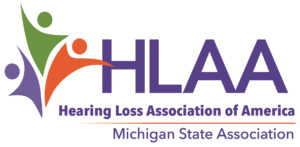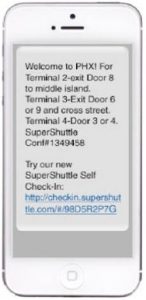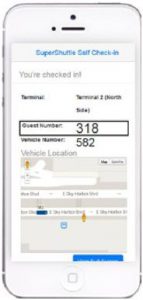By Tony Ferack, Hearing Loss Association of America
For a person with hearing loss, traveling can be a frustrating experience. I recently attended the Hearing Loss Association of America’s (HLAA) national convention in Washington, DC. I do not travel often so I was surprised with how accessible traveling has become. Even though each transportation option claims that they are ADA compliant, it’s a good idea to let them know in advance if you have special needs or are traveling with a service animal. A person with hearing loss does not usually understand announcements when an airline flight or gate changes. When I fly, I look to see if the airline offers email or text alerts when a flight or gate information changes. Attempting to obtain information directly from an airline attendant or via the phone in a noisy environment are not the best options for someone with a hearing loss. Email and texting are our preferred communication methods. I understand that Delta Airlines has installed an induction loop system in the common waiting areas on the A concourse Gates A1-6 and Gates A72-76 at Detroit Metropolitan Airport (DTW). The Gerald R Ford Airport in Grand Rapids has some looped areas also.
I’ve been to Washington, DC in the past and always used the Metro (Washington Metropolitan Area Transit Authority) Rail system to get around. The best thing about the Metro is that it is inexpensive. Perhaps that is the reason that I didn’t research other options. The Metro’s website is good in that there is a lot of trip planning help and a “ticket” can be purchased in advance and mailed to you. There is section on the website that discusses the accessibility features. The biggest drawback, while riding the rail, is that a voice announcement is made for the next stop. I could not understand the announcement. Fortunately, there are maps in all of the rail cars and the stops are clearly marked in multiple locations. In an extreme case, I could know in advance the number of stops that I needed to get to my destination and count the stops. Fortunately, the Washington Metropolitan Area Transit Authority was an exhibitor at the convention! This proved to me that they are indeed concerned about providing for those with hearing loss. I first complemented them for the displays that are in the stations. These let you know the number of arrival minutes for all of the rail cars. I mentioned the difficulty that I had with understanding the announcements in the rail car. They told me that they are updating the rail cars to include announcements on a scrolling display. This would include information about the next stop! Adding the scrolling display would pretty much make the trip 100% accessible to a person with hearing loss. I decided to go one step further and suggested that a smartphone app be developed so that I could track my location in real time while using the Metro system area. They told me that they do not develop apps, but contract that service out. Real time tracking of the rail may not be possible though. Part of the rail system is underground and satellites are used to track position (my car GPS cannot acquire a signal when I’m in a parking structure).
Another option for getting from the airport to the hotel is the SuperShuttle. The SuperShuttle is not available in all cities but it was an option while in Washington, DC. You can book online in advance using a computer or by using their smartphone app. It is very easy! Below, is a screenshot of a couple of screen displays when using their app to book a shuttle while at the airport. The app shows the shuttle location as well as the number on the vehicle. One concern that I heard was that if you are sitting in the back of the shuttle, you may not hear the driver announce the location of the stops. It’s best to let the driver know you have a hearing loss and to make sure you are alerted when you get to your destination.
Other shuttle services are available, such as Park N Rides, where you park in their lot and they shuttle you to the airport. If scrolling displays are not available, make sure to inform the driver about a hearing loss and to alert you at your destination.
Uber was just as impressive. Uber works with a smartphone app so if you do not have a smartphone, then you’ll have to find someone to help. You first create an account to get started. This means entering personal information as well as credit card information. To request a ride, you use the app to set your location. Once an available driver accepts the request, you are given estimated time of arrival, the type and license plate number of the vehicle, and the name and picture of the driver. You can even track the driver’s location on a displayed map. No money is exchanged, unless you decide to give an optional tip. The credit card that was used to register is automatically billed. You can then rate the driver. Simple!
If anyone has any accessible travel experiences to share, I’d love to hear from you. Contact me at [email protected]





